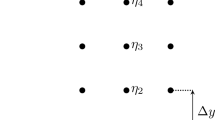Summary
Several high resolution non-oscillatory discretization schemes have been formulated in a finite volume framework for the solution of Euler equations in order to compute inviscid transonic flow fields past airfoils. The theory is based on the local extremum diminishing (LED) principle, initially proposed by Jameson [12], [13] in 1993 for nonlinear scalar conservation laws. Higher order non-oscillatory schemes satisfying the LED criterion have been generated by using a suitable switching function and also by the use of flux limiters. For the implementation of these schemes to the solution of a system of conservation laws, a number of flux splitting techniques have been considered in the present work. Extensive numerical experiments indicate that the flux limited dissipation schemes, viz. the SLIP and USLIP schemes hold the promise of improving the accuracy of the results. The switched scheme with different types of flux splitting has also proved successful in the resolution of shock waves without oscillation.
Similar content being viewed by others
References
Harten, A.: High resolution schemes for hyperbolic conservation laws. J. Comp. Phys.49, 357–393 (1983).
Boris, J. P., Book, D. L.: Flux corrected transport I, SHASTA, A fluid transport algorithm that works. J. Comp. Phys.31, 38–69 (1973).
Roe, P. L.: Approximate Riemann solvers, parameter vectors and difference schemes. J. Comp. Phys.43, 357–372 (1981).
Roe, P. L.: Some contributions to the modelling of discontinuous flows. Lect. Appl. Math., Amer. Math. Soc., Providence, R.I.22, 163 (1985).
Van Leer, B.: Towards the ultimate conservation difference scheme II. Monotonicity and conservation combined in a second-order scheme. J. Comp. Phys.14, 361–370 (1974).
Van Leer, B.: Flux vector splitting for the Euler equations. Proc. 8th Int. Conf. on Numerical methods in fluid dynamics, Aachen, pp. 507–512. (Krause, E. ed.). Lecture Notes in Physics170, Springer 1982.
Osher, S.: Riemann solvers, the entropy condition and difference approximations. SIAM J. Num. Analysis21, 217–235 (1984).
Osher, S., Chakravarthy, S.: Very high order accurate TVD schemes. The IMA volumes in mathematics and its applications2, pp. 229–274 and21, pp. 955–984, Springer 1986.
Sweby, P. K.: High resolution TVD schemes using flux limiters. Lect. Appl. Math.22, pp. 289–309 (1985).
Yee, H. C.: Construction of explicit and implicit symmetric TVD schemes and their application. NASA TM-86775, July 1985. Also in: J. Comp. Phys.68, 151–179 (1987).
Yee, H. C.: A class of high-resolution explicit and implicit shock-capturing methods, NASA TM101088. Also: Von Karman Institute for Fluid Dynamics Lecture Series 1989–04, Computational Fluid Dynamics, Rhode-St-Genese, Belgium (1989).
Jameson, A. (1993): Artificial diffusion, upwind biasing, limiters and their effect on accuracy and multigrid convergence in transonic and hypersonic flows, AIAA Paper 93-3359, 11th AIAA Computational Fluid Dynamics Conference, Orlando, Florida (1993).
Jameson, A. (1993): Computational algorithms for aerodynamic analysis and design. Appl. Num. Math.13, 383–422 (1993).
Balakrishnan, N., Deshpande, S. M.: New upwind method exploiting the wave-particle behaviour of fluid flow. CFD Journal3, (4) 433–446 (1995).
Jain, R. K.: Grid generation about an airfoil by an algebraic equation method. DFVLR-IB-129-83/40 (1983).
Chakrabartty, S. K.: Numerical solution of two-dimensional Navier-Stokes equations by finite volume method. Nat. Aeronaut. Lab. Rep. PD-FM 8726, Bangalore, India. Also appeared as Report DVFLR-IB-129-87/23 (1987).
Chakrabartty, S. K. (1990): A finite volume nodal point scheme for solving two-dimensional Navier-Stokes equations. Acta Mech.84, 139–153 (1970).
Rossow, C.: Comparison of cell centered and cell vertex finite volume schemes. In: Proc. of the 7th GAMM Conf. on Numerical Methods in Fluid Mechanics. Also appeared in Notes on Numerical Fluid Mechanics20, pp. 327–334. Braunschweig: Vieweg 1988.
Jameson, A.: A nonoscillatory shock capturing scheme using flux limited dissipation. Lect. Appl. Math.22, 345–370 (1985).
Jameson, A., Schmidt, W., Turkel, E.: Numerical solution of the Euler equations by finite volume methods using Runge-Kutta time stepping schemes, AIAA Paper 81-1259, AIAA 14th Fluid and Plasma Dynamics Conference, Palo Alto, California (1981).
Swanson, R. C., Turkel, E.: On central difference and upwind schemes. J. Comp. Phys.101, 292–306 (1992).
Cook, P. H., McDonald, M. A., Firmin, M. C. P.: Aerofoil RAE2822-Pressure distributions and boundary layer and wake measurements. AGARD-AR-138 (1979).
Ashill, P. R., Weeks, D. J., Fulker, J. L.: Wind tunnel experiments on aerofoil models for the assessment of computational flow methods. AGARD CP437 (1988).
Stanewsky, E., Puffet, W., Müller, R., Bateman, T. E. B.: Super-critical aerofoil CAST-7 surface pressure, wake and boundary layer measurements. AGARD-AR-138 (1979).
Harris, C. D.: Two-dimensional aerodynamic characteristics of the NACA0012 Airfoil in the Langley 8-foot transonic pressure tunnel. NASA TM 81927 (1981).
Author information
Authors and Affiliations
Rights and permissions
About this article
Cite this article
Ghosh, S., Niyogi, P. A study of non-oscillatory schemes based on LED principle for inviscid flow computation past airfoils. Acta Mechanica 139, 73–90 (2000). https://doi.org/10.1007/BF01170183
Received:
Revised:
Issue Date:
DOI: https://doi.org/10.1007/BF01170183




